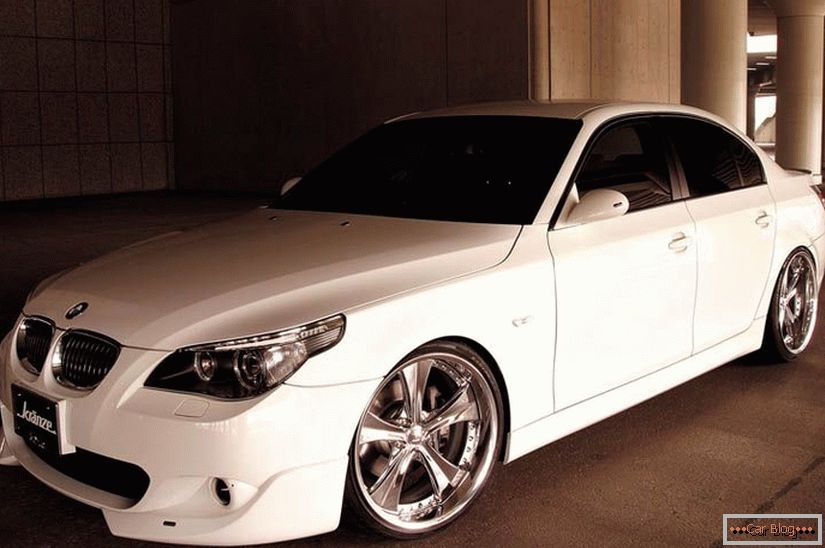Sooner or later, corrosion affects virtually any part made of metal in a car. The main danger of this phenomenon lies in the very rapid development of areas of rust. Therefore, at the first signs of corrosion, it is necessary to perform rust removal followed by anti-corrosion treatment.
Even a new car, if it was not lucky enough to get off the conveyor of a prestigious auto brand, needs protection against corrosion right after the car dealership. High-quality factory protection (for example, a galvanized body) is well opposed to chemical aggression, but it is powerless against the mechanical effects of sand, gravel, crushed stone, and ice pieces. After blows, cracks, scratches, chips that violate the protective coating (anticorrosive) appear.
In addition, we should not forget about the importance of preventive maintenance: periodically inspect and update the corrosion protection as gaps occur.
Content
- 1 What car parts need to be protected?
- 2 Types of corrosion protection
- 2.1 Mechanical (conservation) corrosion protection
- 2.2 Electrochemical corrosion protection
- 3 The procedure for performing anti-corrosion treatment of the car
What car parts need to be protected?
It is no exaggeration to say that anti-corrosion protection is required for every metallic part in a car. This applies not only to the visible surfaces of the body and the bottom, but also, to an even greater degree, to hidden cavities. After all, the car body has a lot of structural elements that have hidden cavities.
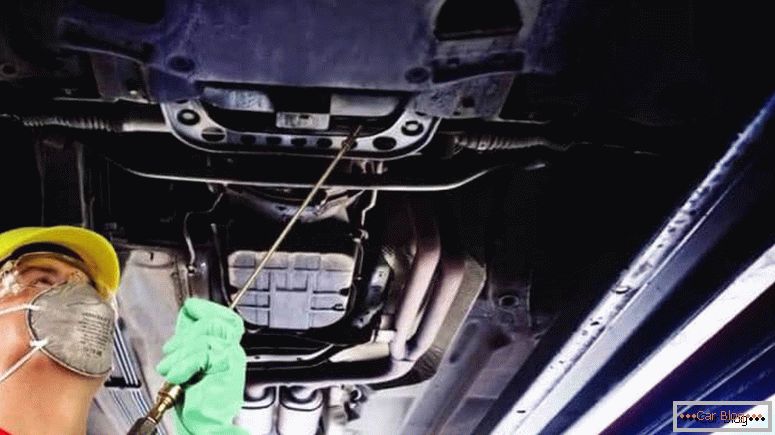
During anticorrosion treatment, pay special attention to hidden cavities.
For each of them, the state of the anti-corrosion coating should be assessed and protective measures taken against corrosion.
- Frame radiator (lower cross member).
- The space between the floor and the front panel.
- Front floor connectors.
- Front floor spars.
- Thresholds floor.
- The cross of the floor is average.
- Rear floor crossbar.
- Rear floor spars.
- Chuck and side connectors.
- Upper mudguard amplifiers.
- Front amp mudguards.
- The bottom surface of the door pockets.
- The space between the mud flaps and the front pillar amplifiers.
- The gap between the inner and outer panels.
Kinds, means of protection against corrosion
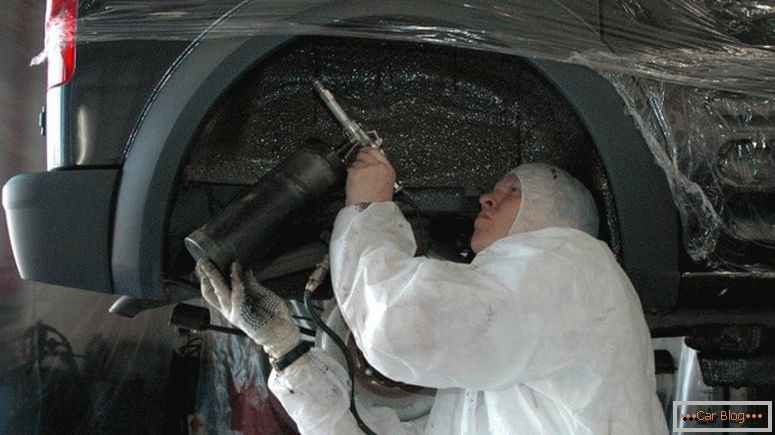
It is more convenient to apply mechanical anti-corrosion protection using a compressor and a special gun
Today, about ten types of corrosion protection are known, and there are several dozens of protective equipment. All of them, of course, have the "right to life." The trouble is that some technologies are applicable only in the factory, others - can be carried out in car services with special equipment. For a car enthusiast who decides to do an anticorrosive do-it-yourself, only two types of protection are available with the appropriate materials for their implementation. These are mechanical and electrochemical methods of protection against corrosion.
See also: We remove scratches on the car with your own handsMechanical (conservation) corrosion protection
The most popular way to protect against corrosion due to its simplicity, the abundance of inexpensive materials on the market, good final results. The method is based on the principle of isolating a metal from atmospheric influence and mechanical effects. Insulation is performed using primers, paints, enamels, varnishes, pastes, mastics. Correctly choose the material for processing will help the instructions on the package. In general, two groups of drugs can be distinguished:
- thick based on polymers, rubber, bituminous resins. They form quite elastic coatings and are intended for processing open areas of the body and the bottom. Apply most often with a brush;
- liquid are based on different oils or waxes. Due to its good ability to penetrate cracks, they are used for treating seams, hidden body cavities, and joints between parts. Sprayed under pressure using a compressor or from an aerosol can.
Thick mastic is the best answer to the question of how better to handle the bottom of the car. Mastics are, for example, rubber-bitumen, slate, bitumen-rubber, etc. The popularity of bitumen mastic is based on their characteristics: they have a relatively low cost, are easy to apply with a brush, excellent in resisting moisture and aggressive compounds. But they also have a drawback: weak mechanical stability (even fragility), especially in frosty weather. Anticorrosion treatment of the bottom of the car falls off right on the road. Application of a special agent on top of the protective mastic helps to solve this problem. In the trading network it is sold under the name "Antigraviy".
“Antigravel” is not a means of anticorrosive protection, but only protects the anticorrosive from mechanical damage caused by impacts of gravel, rubble, sand, etc. about the bottom / body of the car.
Liquid anticorrosive materials are offered by domestic and foreign industry in such a large assortment that it is simply impossible to list everything. Therefore, when choosing, you need to focus on your specific tasks, the degree of metal damage, the availability of the protected area, the convenience of performing anti-corrosion treatment ... It is better to dwell on the brand that offers the widest range of products. Then you can solve any problem with the help of “potions” from one manufacturer. Such an approach will allow not to fear that one tool will diminish or even destroy the action of another.
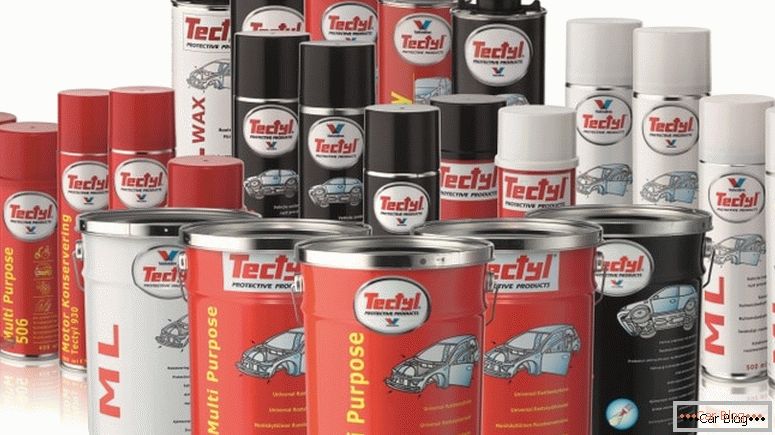
All the necessary anti-corrosion protection is better to choose a single manufacturer
Among the most well-known brands of manufacturers of compositions for anticorrosive protection include Tektil, NOVA, Movil.
See also: How to remove rust from a carElectrochemical Corrosion Protection
A more effective way to protect against corrosion in comparison with the previous one. Based on galvanic processes. Stainless steel (zinc) is deposited on the surface of the steel part, which protects it from corrosion in the future. It turns out excellent adhesion of two metals. The process takes place in an electrolytic solution of zinc salts when exposed to an electric current. It is successfully used when performing primary anticorrosion treatment, as well as for restoring the old damaged anticorrosive.
Zincor-Auto kit, which includes solutions for removing rust, degreasing and applying protection, with a zinc tip electrode, will help to cope with galvanizing at home. An additional advantage is the presence of a wire to connect to the battery or charger. Detailed instructions will tell you how to do it right.
The procedure for performing anti-corrosion treatment of the car
Do not skip the steps and operations involved in the anti-corrosion process: otherwise it will be difficult to achieve a good result. It is especially important to adhere to the sequence of application of chemicals, which is defined by the manufacturer in the instructions. Strictly maintain the recommended pauses between the application of several layers of one agent, as well as the breaks before the next preparation.
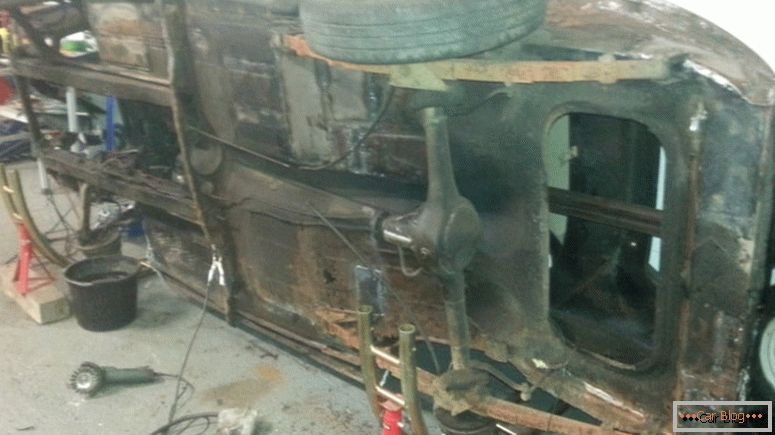
During anticorrosion treatment of the bottom, in the absence of a tipper, the car can be laid on its side
- Work begins with the preparation of the workplace. It can be a lift (ideal), a viewing pit, a ramp. If anticorrosion treatment of the car bottom is performed, then it is advisable to use a tipper: this will provide good access to the bottom sections to be treated.
- When fully processed, all (without exception) elements, parts inside and outside the passenger compartment, including wheels, seats, battery, etc., are removed from the vehicle. In the case of partial processing, only those that may interfere with inspection and subsequent processing.
- Produced a thorough car wash inside and out. It is highly desirable to use hot water (70-80ºC) with high pressure (about 6-10 atm.) And car detergents.
- It is necessary to completely dry the car with warm air using a compressor or a building dryer. In the absence of such an opportunity - leave at least 6 hours for the natural evaporation of moisture.
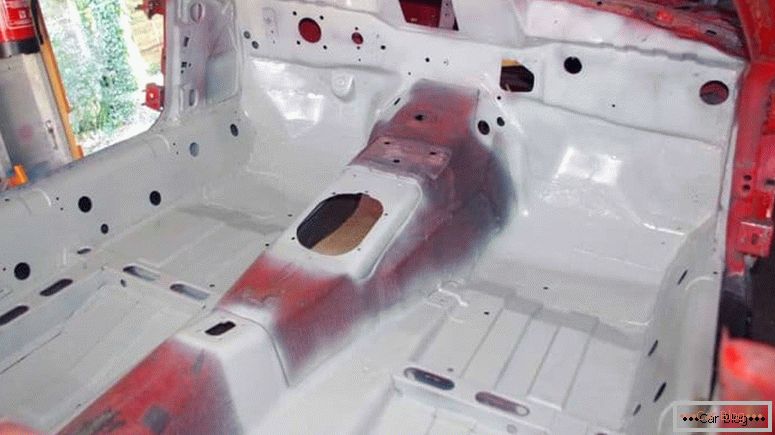
Once every 2-3 years the car is subject to complete disassembly with the implementation of measures for corrosion protection
- An inspection of the cavities and surfaces of the car. Here it is important not to ignore a single "nook".
- The revealed defects are cleaned and processed (if necessary) by a rust converter, a primer.
- The right places are covered with selected anti-corrosion agents. Treatment of hidden cavities should be carried out through the existing technological holes, and also use special nozzles (they are often equipped with spray cans).
- The time required for setting and drying of chemical compounds is maintained.
- The car is being assembled.
- If desired, you can additionally protect the exterior of the body (hood, roof, doors, fenders) with a wax coating.


